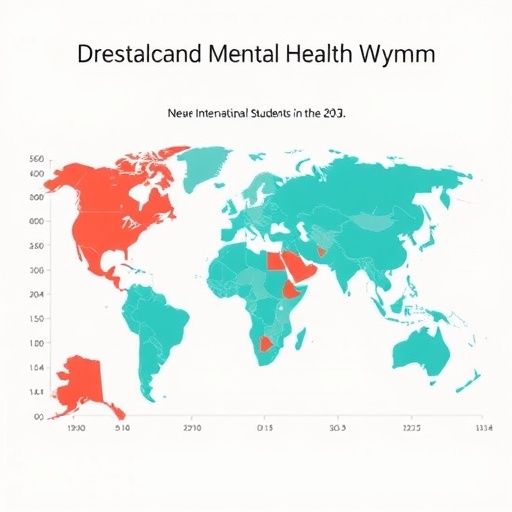In recent years, the mental health landscape for international students enrolled in U.S. higher education institutions has undergone profound shifts. Despite being a crucial demographic contributing more than $40 billion annually to the American economy, these students face escalating psychological distress that remains largely unaddressed. A groundbreaking observational study, published in General Psychiatry, meticulously tracks national trends from 2015 through 2024, revealing alarming increases in anxiety, depression, and suicidal ideation among international students. This comprehensive analysis helps illuminate an often-overlooked crisis, underscoring the urgent need for transformative interventions in collegiate mental health services.
This extensive investigation utilized data from 44,560 international students who participated annually in the Healthy Minds Study (HMS), a robust survey initiative encompassing over 600 colleges and universities across the United States. By examining clinical thresholds for mental health disorders, the study provides a granular understanding of how widespread and severe these conditions have become. The large sample size and longitudinal scope make this research particularly significant for policymakers, university administrators, and mental health practitioners seeking evidence-based insights.
The findings are stark: anxiety prevalence among international students surged from 20% to 36%, while depression rates nearly doubled from 20% to 35%. Perhaps most concerning is the doubling of suicidal ideation, which rose from 5% to 10% over the same timeframe. This tripartite escalation signals a deepening mental health emergency within the international student community, highlighting systemic vulnerabilities that merit urgent attention. Yet, despite these mounting challenges, access to counseling and mental health support services showed only marginal growth, increasing from a mere 5% to 8%.
This disparity between rising psychological distress and stagnant service utilization encapsulates a widening gap in mental health care delivery. Lead author Dr. Yusen Zhai from the University of Florida emphasizes the mismatch, noting that “international students face unique cultural, linguistic, and social barriers that traditional campus services often fail to address adequately.” The study suggests that conventional counseling models may lack the cultural competence and accessibility required to meet the nuanced needs of this diverse population, thereby perpetuating unmet mental health demands.
Several compounding factors contribute to these troubling trends. Academic pressures intensified by rigorous coursework, stringent deadlines, and competitive environments create a constant state of stress. Financial difficulties, often exacerbated by limited work opportunities and high living costs, further strain students’ resilience. The challenges of cultural adjustment—navigating new social norms, language barriers, and potential discrimination—generate feelings of isolation. These multifaceted stressors converge, triggering or exacerbating mental health problems that may remain hidden due to stigmatization and fear of repercussion.
The gender disparities observed in this study reveal additional layers of complexity. Female international students reported significantly steeper increases in anxiety and depression compared to male counterparts. This aligns with broader epidemiological patterns yet also reflects culturally entrenched stigmas that frequently discourage males from seeking psychological help. Such findings underscore the necessity for gender-sensitive mental health strategies that recognize and address these distinct experiences and barriers.
Interestingly, the study documents a temporary but meaningful dip in anxiety and depression rates during the 2019–2020 period, coinciding with the global COVID-19 pandemic’s initial stage. Researchers postulate this phenomenon resulted from increased family involvement due to lockdowns, as well as universities adopting more flexible academic policies and proactive outreach programs. This transient improvement not only highlights the impact of systemic support and flexibility on mental well-being but also suggests valuable lessons for future mental health interventions.
As the implications of deteriorating mental health extend beyond individual suffering, the study warns of broader consequences for the U.S. academic ecosystem. Over 1.1 million international students enhance campus diversity, enrich educational environments, and sustain significant economic contributions. Diminishing mental health could jeopardize these benefits by deterring future enrollments if students and families perceive American universities as neglecting their psychological safety. This potential decline threatens the country’s competitive edge in global education markets.
To mitigate this looming crisis, the authors advocate for comprehensive reforms. Expanding culturally competent, multilingual counseling and mental health services is paramount to bridging care gaps. Amplification of peer support networks could foster community engagement and destigmatize help-seeking behavior. Moreover, innovative digital tools such as AI-enabled chatbots present promising adjunctive solutions capable of offering accessible, evidence-based mental health support at scale. Continued surveillance and rigorous research remain essential to monitor emerging trends and evaluate intervention efficacy.
This study’s revelations carry a powerful ethical and pragmatic imperative. Providing equitable mental health care to international students is not merely a moral obligation but a strategic investment in sustaining the vitality and inclusiveness of higher education. Institutions that proactively respond to these challenges will likely enhance student outcomes, retention rates, and institutional reputation, thus reinforcing their role as global academic leaders.
The data and analysis presented by Dr. Zhai and colleagues bring into sharp focus the pressing need for holistic mental health frameworks tailored to the international student experience. Only through concerted, culturally informed efforts can the widening divide between mental health challenges and support services be effectively narrowed. As this vulnerable population continues to expand, prioritizing their psychological well-being must become central to campus policies and national educational agendas alike.
Ultimately, this pioneering study serves as a clarion call to action. By fostering environments where international students feel understood, supported, and empowered, higher education can uphold its commitment to cultivating diverse, resilient, and thriving communities. The future of global academic excellence hinges on addressing these rising mental health challenges with urgency, empathy, and innovation.
Subject of Research: Mental health trends and service utilization among international students in the U.S. higher education system from 2015 to 2024.
Article Title: National trends of mental health and service utilisation among international students in the USA, 2015–2024
News Publication Date: 30-Sep-2025
Web References: DOI: 10.1136/gpsych-2025-102124
Image Credits: Yusen Zhai; Yiying Xiong; Mahmood Almaawali; Xihe Tian; Xue Du.
Keywords: Mental health, anxiety, depression, suicidal ideation, international students, counseling services, higher education, cultural competence, AI mental health tools, psychological distress, Healthy Minds Study, COVID-19 pandemic impact




